Bridging the gaps: Work crews complete important UP projects
By JOHN PEPIN
Michigan Department of Natural Resources
Tucked into the Michigamme Highlands of Marquette County, on the east side of Michigan’s most remote state park, the crisp autumn air carried sounds unfamiliar to this quiet locale – the whining of electric saws and the banging of hammers.

Here at Craig Lake State Park, a Michigan Department of Natural Resources crew was replacing battered and warped foot bridges with elevated boardwalks over the East and West branches of the Peshekee River.
In fact, these industrious sounds of dedicated construction crews have been heard at several DNR facilities in the Upper Peninsula over the past several weeks.
Crews have been working in creative partnerships to beat the seasonal clock, trying to finish up projects before the snow flies.
North Country Trail
The rugged and remote backcountry of Craig Lake State Park presented more than one challenge for workers completing the pair of elevated boardwalks along the North Country National Scenic Trail.
Each of the reinforced fiberglass boardwalks – heavier and more durable than aluminum – measured 44 feet long and 4 feet wide.
The first hurdle was transporting the long, framework stringers to the worksite, which was located up a bumpy, black-topped road, then in a couple of miles on a dirt road to a gravel pit staging area.
|
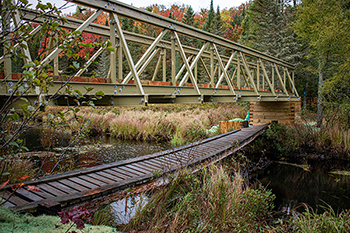
From that location, it was more than a mile down the hiking trail to the first bridge and farther west to the second. The DNR lacked the personnel or the equipment to get the construction items to these remote building sites.
“Hauling in the 44-foot-long stringers by our staff was a logistical nightmare,” said park supervisor Debra Gill. “The National Guard took on the challenge and thought outside the box to get our kits into the field. The day they pulled in with one of their buses was both humorous and a great idea!”
The Michigan Army National Guard 107th Engineer Battalion used transportation assets to move the stringers to the gravel pit and then, as a group, walked the long sections to each of the building locations.
Most of the materials needed to construct the bridge abutments were hauled to the streamside by volunteers from the North Country Trail Association.
“If it wasn’t for these two separate entities, we wouldn’t have been able to even get started,” Gill said.
|
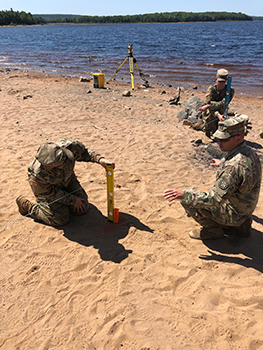
The east boardwalk was built first, providing a way to more easily access the second bridge.
“Accessibility to this bridge required some creativity, additional construction materials and time to move materials to the site,” Gill said. “Ramps were built to get equipment and materials across, which saved time for staff having to haul by hand.”
Parts were removed from off-road vehicles to allow the vehicles to fit the bridge width as workers carried wood and other building materials to the second construction location.
The DNR’s Lake Gogebic State Park road crew provided the core of the construction team, which was rounded out with Gill and rangers and other staffers from Van Riper State Park.
The association split the $53,770 cost of the two boardwalks with the DNR. Another roughly $15,000 for the project came from the DNR’s State Park Improvement Fund.
Silver Lake Basin
Earlier this month, the National Guard battalion also assisted the DNR by completing a boating access site project in Marquette County at the Silver Lake Basin, northwest of Ishpeming.
Silver Lake is a place known to anglers for its northern pike, bass and panfish.
In May 2003, a fuse plug failed on the dam there releasing 9 million gallons of water downstream, which ultimately led to the failure of the Tourist Park Dam, situated several miles away in Marquette.
Mitigation funds from the incident were used to fund the $66,000 boating access project.
|
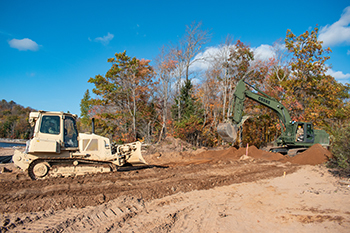
In February 2020, after proposing gated, walk-in access only to the lake, the DNR held a public meeting in Negaunee Township. Attendees at the meeting opposed that idea, instead favoring modest improvements, keeping the access site a gravel boat launch with vehicle access provided.
Men and women with the National Guard staged equipment up the road from the badly worn and washed-out entry road to the access site.
The road was covered with sand and other base material and flattened with a roller. Bulldozers also worked the road and smoothed sands and gravel at the boat launch, which angled down a slope to the water’s edge.
A front-end loader and chainsaws were used to remove a few trees to expand the parking area. The work was completed over a four-day period.
“This partnership provided the National Guard a venue to conduct their training exercises in heavy equipment operation, field surveying and project management in the event they are called to deploy for emergency situations in Michigan,” said Dan Dowdy, who is working out of class as a regional field planner for the DNR in Baraga. “The project was a great success for both state of Michigan entities, and the National Guard produced an outstanding result.”
Bond Falls Scenic Site
In September, DNR staff from the Parks and Recreation Division aided volunteers with a Michigan Cares for Tourism facilities rehabilitation project at the Bond Falls Scenic Site in Ontonagon County.
The Michigan Cares for Tourism program began in 2012, with the DNR, Travel Michigan, Indian Trails, Grand Valley State University, an organization called Tourism Cares that did similar events on a national level and a marketing company called Driven partnering to help restore historic attractions in Michigan.
|

The aim was to bring the tourism industry together to donate time, resources and effort to complete backlogged maintenance projects. A board of 20 organizes the group’s projects, taking on one each autumn.
In its first six years, the organization empowered 2,365 volunteers over 10 projects, including seven multiple-day efforts. Work in the U.P. was done at Fayette Historic State Park in Delta County and Fort Wilkins Historic State Park in Keweenaw County.
This year, to help aid the tourism industry hit hard by the coronavirus pandemic, Michigan Cares for Tourism organized a “30 Days of Giving” tour, which gathered a total of 280 volunteers and 26 donors for seven events at historic, cultural and natural attractions across the state.
At Bond Falls, on the Middle Branch of the Ontonagon River, the team worked to replace aged and worn decking on two walkway bridges situated just downstream of the beautiful and popular waterfall. Handrails were replaced, brush removed from trails and restrooms painted.
|

DNR Parks and Recreation Western U.P. Supervisor Doug Rich told WLUC-TV6 news that the bridge-boardwalk updates were an especially important part of the project, as they keep the falls safe for viewing and accessible to all visitors.
“It’s a place they (visitors) find spiritual rest and renewal,” Rich said. “That’s what Bond Falls represents, that inclusiveness for all people of all accessibility needs.”
Additional locations on the Michigan Cares for Tourism tour included the DNR’s Lime Island Recreation Area in the eastern U.P., Island Lake State Recreation Area in Livingston County, Binder Park Zoo in Battle Creek, Botanic Gardens in Traverse City, Muskegon State Park and Muskegon Luge Adventure Sports Park and the Thunder Bay Marine Sanctuary on Lake Huron.
Interstate trail connection
In Dickinson County, a nearly 400-foot-long former railroad bridge, perched 50 feet above the Menominee River, is now providing interstate trail access between Iron Mountain, Michigan and Florence County, Wisconsin.
|
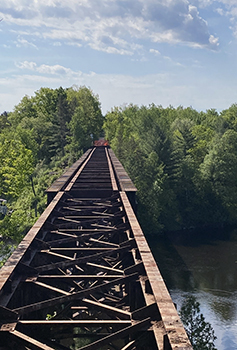
That’s thanks to a two-phased construction project that has been developed over the past several years, with the help of more than one partnership.
In 1984, the Tri-County Snowmobile Club purchased the Menominee River Bridge from the Chicago and Northwestern Railway with the vision of securing a permanent trail connection between Michigan and Wisconsin.
The 14-foot-wide bridge, with a double intersection Warren deck truss, was built in 1911 by the American Bridge Co. of New York for the Chicago and Northwestern Railway.
In 2015, the DNR entered into an agreement with the Florence County Forestry and Parks Department to jointly fund bridge upgrades and create a multi-use interstate trail crossing.
The bridge connects state-managed trail in both states and forms part of the Stateline Rail Grade, which winds through parts of Wisconsin to Wakefield, Michigan, offering more than 100 miles of trail connectivity.
As part of the development agreement, the DNR accepted the gift of this bridge from the Tri-County Snowmobile Club in 2017.
The initial phase of revitalizing the bridge – a more than $1.5 million project – was completed recently, and the span is now open for use. Zenith Tech, Inc. of Waukesha, Wisconsin was the contractor, and OHM Advisors of Hancock engineered the project.
“This bridge incorporates many new design elements to ensure that our users enjoy a safe and long-term interstate trail connection,” said Jeff Kakuk, DNR western U.P. trail specialist.
|
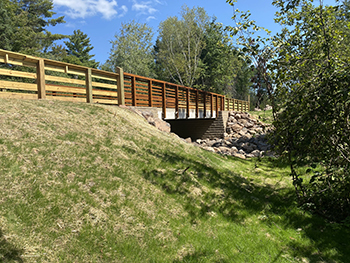
This crossing provides many opportunities for trail users to connect between the trail systems in the two states.
“This bridge has been a major connection for the MI-WI snowmobile and ATV trail systems,” said Pat Smith, Florence County Forestry and Parks administrator. “Thanks to the efforts of the Michigan DNR and Florence County Forestry and Parks Department, the bridge will remain that connection for many more years.”
The second phase of construction is slated to begin next summer. It consists of water grout repairs on the limestone bridge abutments, above and below the waterline. This final phase of construction will not affect trail use.
More spans
More bridgework engineered by OHM Advisors was recently finished in the western U.P., providing important trail upgrades.
A $319,482 project to construct a 45-foot-long, Geosynthetic Reinforced Soil Integrated Bridge System – which is cost-effective and incorporates part of the trail into the superstructure of the bridge – was completed over McVichie Creek in Wakefield Township in Gogebic County.
The contractor was Ruotsala Contracting, LLC of Ironwood. This improvement was part of the Stateline Rail Grade extension project, which opened the multi-use trail to Wakefield.
|

In Baraga County, a trestle over the Little Carp River was improved by MJO Contracting of Hancock in a bridge project costing $707,231. The 221-foot-long span is part of the Baraga-Arnheim Rail Grade. Culvert work under the trestle, in addition to three other culvert replacements, comprised a second phase of this project.
From the secluded backwaters of the Peshekee River at Craig Lake State Park to the beauty of Bond Falls and the Silver Lake Basin and the utilitarian function of important rail-trail connectors in the western U.P., the Michigan DNR has been working hard, through the help of diverse partnerships, to improve access to numerous facilities and natural resource wonders.
These marvelous improvements now realized can be enjoyed today, and they will hopefully endure into the future to provide recreational opportunities for successive generations to come.
|
Check out previous Showcasing the DNR stories in our archive at Michigan.gov/DNRStories. To subscribe to upcoming Showcasing articles, sign up for free email delivery at Michigan.gov/DNR.
Note to editors: Contact: John Pepin, Showcasing the DNR series editor, 906-226-1352. Accompanying photos and a text-only version of this story are available below for download. Caption information follows. Credit Michigan Department of Natural Resources, unless otherwise noted.
Text-only - Showcasing Story - Bridges
Bridge: Charlie Perttu and Dan Talkowski, of the Lake Gogebic State Park road crew, work on a raised boardwalk over the East Branch of the Peshekee River at Craig Lake State Park.
Carp: Workers make progress on a rehabilitation project for a trestle over the Little Carp River in Baraga County.
Complete: Completed bridge decking is shown on the Menominee River Bridge, connecting a Michigan and Wisconsin state border trail.
Decking: Doug Rich, left, Michigan Department of Natural Resources western Upper Peninsula parks and recreation supervisor, and Dan Talkowski, of Lake Gogebic State Park, work to improve bridge decking over the Middle Branch of the Ontonagon River at Bond Falls.
Exposed: A former railroad bridge over the Menominee River is shown exposed with the decking removed. The bridge connects Michigan and Wisconsin via a recreational trail.
Guard: Members of the Michigan Army National Guard’s 107th Engineers Battalion work along the shoreline of Silver Lake in Marquette County.
Launch: Heavy equipment was used to move earth at a boating access site improvement project at Silver Lake in Marquette County.
Load: Workers on a Michigan Cares for Tourism project at the Bond Falls Scenic Site in Ontonagon County stack bridge timbers.
McVichie: The completed Geosynthetic Reinforced Soil Integrated Bridge System over McVichie Creek in Wakefield Township in Gogebic County is shown.
New: The new raised boardwalk is shown, above the old trail bridge, along the North Country National Scenic Trail at Craig Lake State Park. The span crosses the East Branch of the Peshekee River.
Survey: Members of the Michigan Army National Guard’s 107th Engineers Battalion work along the shoreline of Silver Lake in Marquette County. (Michigan Army National Guard photo)
|